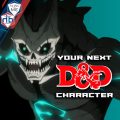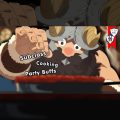ㅤㅤ
Kamen Rider W is a special entry in Toei’s mega-franchise, where detective noir crime drama overlaps with blood-pumping action and pyrotechnics sequences. Its main hook is the titular Kamen Rider having two people in one body.

Suppose you’ve got that itch to play in that style of adventure, all while using unique mechanics for both players and monsters. In that case, DM V has a custom 5e homebrew that guides DMs to run a superhuman monster crime family, a whole bunch of magic items to help carry the narrative, and of course, a bunch of player options from magic items, races, feats, and even TWO NEW subclasses to bring Kamen Rider W to your D&D table!
In DM V’s YouTube show Husbando Homebrew, he takes pop culture to pen and paper—and Kamen Rider is just one of his bigger homebrew creations.
What’s Kamen Rider W?
Kamen Rider W is a 2009 special effects show by Toei Company featuring the half-boiled detective Hidari Shotaro and his living search engine partner Philip, as they solve superhuman monster crimes orchestrated by the big bad crime family, Museum. When push comes to shove, Philip and Shotaro put their heads together and transform into the titular hero, Kamen Rider Double!
Kamen Rider W Homebrew Design Goals
This homebrew has a lot of moving parts, and much like how DM V made the Geats homebrew document, it also contains some guidelines on how to create a W-themed setting.

He first sets the stage with the following design goals:
- Design the mechanics to carry the narrative.
- This is the main driving force of the homebrew. My design sense is always trying to bake story elements into the mechanical crunch of the features.
- Keep the features balanced, as long as they fit the narrative element.
- DM V always tries to keep the story elements top-of-mind, but as much as he can, he wants the features to be balanced enough such that DMs can allow them at their tables with little to no tweaking.
- Design with flexibility in mind.
- While the mechanics are written to bake in narrative elements, he also makes it a point to avoid hard-locking the features to a specific setting. He also created a lite version of the document in case some tables just wanna try it out first, but more on that in a bit.
- LASTLY, and this is pretty big, he created TWO ways for players to roleplay as Kamen Rider W: one using magic items and one using subclasses. Again, more on that later.
Now, is everybody comfy at the table? Make sure you insert that Like Gaia Memory, and henshin!
Welcome to the Windy City
The story is set in the Windy City of Fuuto, a modern Japanese hub landmarked by its tall wind turbine. Working in the shadows of this idyllic city is Museum, a criminal syndicate that exploits, develops, and distributes these addicting pieces of power called Gaia Memories.

That’s a lot of moving parts, and stat blocks aside, that’s a lot of mechanical items you have to build. But lemme help you out with the first part!
The first chapter of the homebrew is a setting guide. It’s no gazetteer by any means, but my intended use for this chapter is to serve as a list and inspiration for the various narrative elements present in Kamen Rider W.
Obviously, this part is mostly useful for DMs, but what can players get from this section? Well, the descriptive list of factions and roles can help players find character inspiration. Like, say, a former dealer of Gaia Memories who turns to the side of good.
On the topic of characters, one key character of the setting is the living conduit of knowledge named Philip. In many ways, he’s the main protagonist of the show, while Shotaro is the main perspective the story is told through.
Philip has DEEP connections to Museum, is the driving force behind the true conflict, and is the main beneficiary of the resistance group’s benefactor. He has the power to literally Google search the planet to find plot points. This could be your next character, with the new playable race based on Philip!

This race has Intelligence-based traits, like a modified guidance spell, daily proficiency changes, various divination spells as you gain levels, and a gentle repose after death. Which hopefully you don’t have to use.

Of course, DM V didn’t neglect to give the other heroes of the show some love, but since these guys are more or less human, he instead created character-inspired feats. Two out of the three feats are magic item related since W uses a lot of magic items in its narrative.
Artifact resilience gives you a pseudo-legendary resistance against effects caused by magic items. Magically attuned gives you a buff as long as you’re attuned to a magic item, like extra force damage or a saving throw bonus. And lastly, Steadfast lets you pull a character arc by giving you additional defenses against being frightened and against being dead.

We’ve got some of the building blocks of the setting now, but Kamen Rider’s main selling point is the transformations, be it from the heroes who turn into Kamen Riders or villains who turn into dopants. Specifically villains like Sonozaki Saeko, who transforms into the Taboo Dopant, whose transformation is the only monster that DM V wants to step on—hmmm.

Henshin to Greater Heights
A humongous chunk of the homebrew is dedicated to the very many magic items found in the series. But they actually have a bit of a trick to them to pull off the Kamen Rider fantasy.
See, DM V built them to work like miniature systems disguised as magic items. We’ll get to the DM-specific items in a bit, but for players, transformation mechanics are mainly outlined under the transformation drivers section. Each transformation driver offers some variety in what they do, but their real purpose is to outline the transformation mechanics, from putting on the belt to saying the magic words “Henshin!”

You’ll first have to wear the belt on your turn or when you roll initiative, and then slot in a Gaia Memory, which you can do in various ways that hopefully mitigates any risk of being caught without your armor.
But while the drivers tell you HOW to transform, it’s the Gaia Memories that tell you WHAT you transform into. You can find these in the Atlas Mind section of the document. Yeah, side note, DM V had to change a bunch of names to avoid using the names of trademarked items.

So, each Gaia Memory tells you a little bit about the visual aspect of your transformation, but they also show what kind of buffs and bonuses you get from them. Take the Metal Gaia Memory for example, which grants a physical damage reduction and a magic weapon, or the Heat Gaia Memory, which adds fire damage to your attacks. Also, each one tells you the kind of finisher you can use.
Now you might be thinking, “DM V, you majestic mallard, Kamen Rider W is two characters sharing the same body! How did you pull it off?” With great effort, imaginary mallard. With great effort.
Kidding aside, the Doublesoul Driver outlines how you and your partner can transform AND the many different properties your partner gets while he’s inside you—
It tells you how damage works between the two characters, the kind of space you occupy, and all other edge cases that HOPEFULLY make for smooth gameplay.
Bonus points, DM V wrote the Gaia Memories to be compatible even with the non-W drivers! You can make your own Kamen Rider OC, like Accel using the Luna memory or something or W using Cyclone Accel.

Players can also find the various detective tools that Shotaro uses, like his beetle cellphone or bat camera. And of course, a motorcycle that puts the Rider in Kamen Rider. The full version of the homebrew even has the massive Revolgarry that lets you change up your flavor of motorcycle.
There are two more character options that he created, but let’s park that for a bit and discuss the magic items for monsters IN…
Humans and Horrors
The Atlas Recalls section outlines the various items that the DM can use to transform NPCs into the W’s monstrous Dopants.

In the series, Dopants are humans who use these USB-like devices to transform into the monster of the week. Most of them have a biological interface, but the big wigs in Museum use their own belts—because the truth of these Gaia Memories is that they tend to be degenerative and addicting at the same time.
So DM V wrote those qualities down! The Atlas Recall item is a generic magic item that all the other variants fork off from. It shows how attunement works, how corruption works, and how it tends to encourage this positive feedback loop to keep users hooked on its power.
And just like transformation drivers, the Atlas Recall has its own transformation mechanic, where users can insert the USB into themselves at varying points in the initiative order.

The different major Atlas Recalls are typically reserved for very powerful Dopants like Weather, Taboo, or Terror, while the minor Atlas Recalls are for the monsters of the week, even the weird ones like Money or Virus.
While he didn’t create individual stat blocks, he did put in a designer’s note indicating how these are intended to be used and a ballpark estimate on how these items can alter an NPC stat block. It’s not perfect, and as much as DM V wanted to create stat blocks for all 30+ Dopants, he didn’t want to extend the development of this homebrew by another 2 or 3 months.
The other reason why he created magic items is because he wanted to give DMs the opportunity to create new stories with players. Say, for example, a player wants to play as a former distributor of Gaia Memories, but they saw the damage they were causing and decided to turn to the forces of good, and the only way to fight back against the monsters is to use Atlas Recalls themselves while trying to stave off the corruption. Perhaps later on, they might even become a Kamen Rider.

Speaking of Kamen Riders, he did mention subclasses. Let’s go check these out, IN…!
Cyclone and Joker
The two subclasses are alternative ways your table can pull off the character fantasy of playing as Kamen Rider W. DM V did this because some DMs are more comfy managing magic items, while other DMs might be more willing to allow subclasses at their table instead of adding in an entire suite of magic items.
The Planesmind Conduit is an artificer subclass inspired by Philip, while the Planesmind Confidante is a fighter subclass inspired by Shotaro. He took some liberties by giving both of them armor transformation features to make it easier to play.
The Soul Forward feature from the Planesmind Conduit, on the other hand, is the one that facilitates the 2-in-1 transformation fantasy. And yes, both subclasses can don multiple forms.

Both subclasses are fully featured, with higher levels improving the core armor features of the subclass. You can find these subclasses under the Variant Character Creation options of both the pared-down version and the full version.
Now, you’re probably wondering what DM V meant when he said there’s a lite version and a full version of the document. The lite, or free version, which can find as a link on the Ko-Fi shop page contains the setting elements, the race, the feats, and the necessary magic items to fulfill the Kamen Rider W fantasy. It even has two subclasses based on Philip and Shotaro.
The main difference between this and the full version is the amount of items included in each section. This includes other Kamen Riders like Accel and Eternal via magic items, more W forms like Fang and Xtreme, more gadgets, more vehicles, and A LOT more dopants.

He put in a lot of work on this massive 50-plus-page document, and we both think it’s worth the cost. But if you want to get a feel for it first, the free version lets you check out the quality of the homebrew and still gives you the entire intended experience. The full version, on the other hand, gives you a lot more options to play with, because he made sure to cover as much of the details as he could from the TV series!
Also, purchasing it keeps the channel afloat, and any support you send is greatly appreciated! He does even more homebrew for Kamen Rider, with documents to play Kamen Rider Geats and Kamen Rider Build!
By the way, there’s a secret 40% discount code hidden in the video! If you figure it out, don’t spoil it in the comments, but feel free to brag about it!







